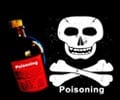A new study has documented for the first time the process in which increased mercury emissions from human sources across the globe, and in particular from Asia, make their way into the North Pacific Ocean and as a result contaminate tuna and other seafood.
The study, by researchers at the US Geological Survey (USGS) documents for the first time the formation of methylmercury in the North Pacific Ocean.Methylmercury is a highly toxic form of mercury that rapidly accumulates in the food chain to levels that can cause serious health concerns for those who consume the seafood.
The study shows that methylmercury is produced in mid-depth ocean waters by processes linked to the "ocean rain."
Algae, which are produced in sunlit waters near the surface, die quickly and "rain" downward to greater water depths.
At depth, the settling algae are decomposed by bacteria and the interaction of this decomposition process in the presence of mercury results in the formation of methylmercury.
Many steps up the food chain later, predators like tuna receive methylmercury from the fish they consume.
Advertisement
Mercury researchers typically look skyward to find a mercury source from the atmosphere due to emissions from land-based combustion facilities.
Advertisement
Instead, it appears that the recent mercury enrichment of the sampled Pacific Ocean waters is caused by emissions originating from fallout near the Asian coasts.
"The mercury-enriched waters then enter a long-range eastward transport by large ocean circulation currents," said USGS scientist and coauthor David Krabbenhoft.
Scientists sampled Pacific Ocean water from 16 different sites between Honolulu, Hawaii and Kodiak, Alaska.
In addition, the scientists constructed a computer simulation that links atmospheric emissions, transport and deposition of mercury, and an ocean circulation model.
"This unprecedented USGS study is critically important to the health and safety of the American people and our wildlife because it helps us understand the relationship between atmospheric emissions of mercury and concentrations of mercury in marine fish," said Secretary of the Interior Ken Salazar.
"We have always known that mercury can pose a risk, now we need to reduce the mercury emissions so that we can reduce the ocean mercury levels," he added.
Source-ANI
LIN









